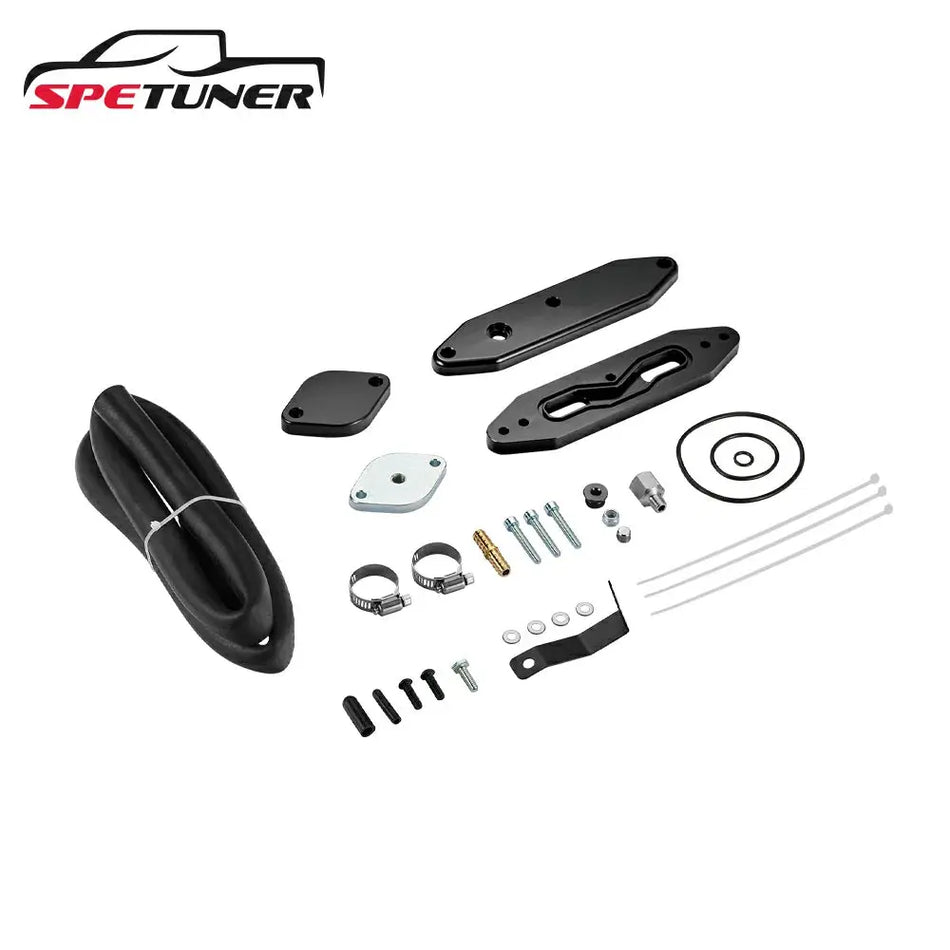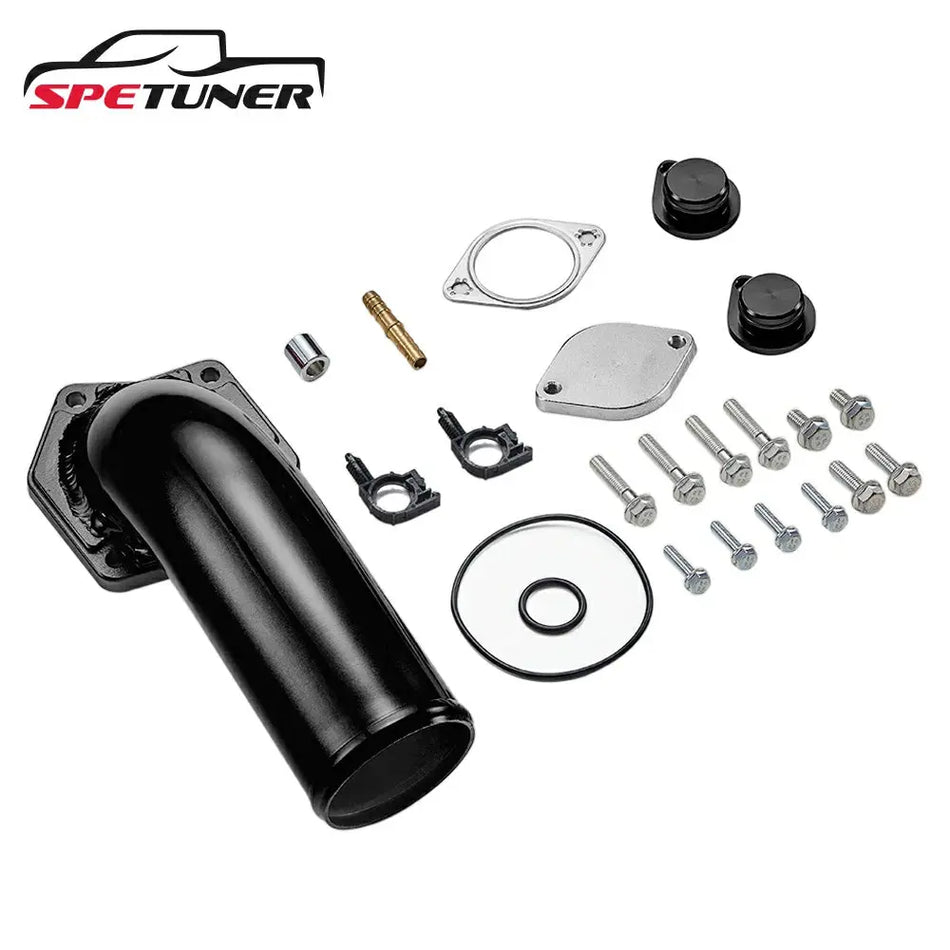Emissions control systems play a key role in reducing pollution and improving fuel efficiency in today's diesel engines. The EGR valve is one of the most critical components in this system.
Whether you're a diesel truck owner, DIY mechanic, or just curious about how your engine works, understanding the EGR valve is essential, especially if you're considering performance upgrades like an EGR delete.
Let’s break down what the EGR valve does, how it works, what happens when it fails, and how it ties into performance tuning for diesel trucks.

What Is an EGR Valve and Why Is It Important?
What Is an EGR Valve?
The Exhaust Gas Recirculation (EGR) valve is a key part of your engine’s emissions system. Its main job is to reduce harmful nitrogen oxide (NOx) emissions by recirculating a portion of your engine’s exhaust gases back into the combustion chamber.
The EGR valve lowers the combustion temperature inside the cylinders by reintroducing exhaust gas into the intake stream. This helps reduce the formation of NOx, which forms at high temperatures and is a major contributor to air pollution and smog.
Why Is It Used in Diesel Engines?
Diesel engines naturally produce higher combustion temperatures due to their efficiency and compression ratios. That means more NOx emissions—unless you have systems like the EGR to manage it. Many trucks wouldn’t meet emissions standards like the EPA or Canada’s on-road diesel rules without an EGR valve.
Where Is It Located?
In most trucks, the EGR valve is mounted between the exhaust manifold and the intake manifold. Depending on your vehicle, it’s controlled by a vacuum actuator or an electronic stepper motor. In modern diesels, the EGR valve works alongside other components like the EGR cooler and DPF (Diesel Particulate Filter) to manage exhaust flow and temperature precisely.
How Does the EGR Valve Work in a Diesel Engine?
Understanding how the EGR valve works helps you recognize its impact on performance and emissions. Due to higher combustion pressures and temperatures, this process is a bit more complex in a diesel engine than in gasoline engines.
The Role of Exhaust Gas Recirculation
When your diesel engine runs, it produces hot exhaust gases rich in nitrogen oxides (NOx). The EGR valve redirects a measured portion of these exhaust gases back into the intake system, where they mix with fresh air before entering the combustion chamber again.
This exhaust-air mix reduces the oxygen concentration and raises the water vapor content in the intake charge. As a result, combustion temperatures drop, preventing excess NOx formation and keeping the engine emissions-compliant.
EGR Operation at Different Engine Loads
The EGR valve doesn’t stay open all the time. It responds to real-time data such as engine load, RPM, and temperature:
Low Load/Idle: The EGR valve may open slightly to keep emissions in check without affecting combustion too much.
Cruising Speeds: EGR flow increases, maximizing emission control during steady-state driving.
Full Throttle/Heavy Load: The EGR valve typically closes to allow maximum air and fuel for power generation.
This controlled modulation ensures optimal engine performance while meeting emission standards.
Electric vs. Vacuum-Controlled EGR Valves
There are two main types of EGR valves used in diesel trucks:
Vacuum-Operated EGR Valves
Found in older diesel models, these use engine vacuum and a diaphragm to regulate the valve’s position. They’re more straightforward but less precise, and often slower to respond.
Electronically Controlled EGR Valves
Common in modern trucks like the Ford Powerstroke, RAM Cummins, or GMC Duramax, these use sensors and the engine’s ECU to precisely open and close the valve. Due to their complexity, they offer better control over emissions and engine efficiency, but are more prone to issues like clogging.

Symptoms of a Failing or Blocked EGR Valve
Like any component in your diesel truck, the EGR valve can wear out or get clogged over time, especially if you frequently tow heavy loads, idle often, or don’t keep up with maintenance. A faulty EGR valve can cause serious drivability issues, reduce fuel economy, and damage your engine over time.
Here are the most common signs that your EGR valve is failing or blocked:
Rough Idling and Power Loss
When the EGR valve gets stuckToointake stream. This disrupts the air-fuel mixture when the EGR valve gets stuck open, causing:
Uneven or rough idling
Engine hesitation
Loss of acceleration or throttle response
You’ll likely feel your truck "bog down" when accelerating.
Increased Fuel Consumption
A malfunctioning EGR valve can alter the combustion process, which often results in:
Poor fuel efficiency
Higher fuel costs over time
Increased soot buildup in other exhaust components, like the DPF
This issue worsens if the valve is stuck closed or partially clogged, causing hotter combustion cycles and more fuel injection.
Check Engine Light (CEL)
If your EGR valve fails to open or close properly, your truck’s ECU will detect abnormal airflow and trigger the check engine light. Common EGR-related fault codes include:
P0401: EGR Flow Insufficient
P0402: EGR Flow Excessive
P0404: EGR Circuit Range/Performance
A diagnostic scan will confirm if the issue is EGR-related.
Black Smoke from Exhaust
Blocked or stuck EGR valves often produce a rich fuel mixture, especially under load. This causes:
Excessive black smoke from the tailpipe
Strong diesel or fuel smell from the exhaust
Eye irritation from fumes
✅ Answering PAA: "What are the symptoms of a blocked EGR valve?"
These include rough idle, black smoke, poor MPG, power loss, and a glowing check engine light. If you notice any combination of these, it’s time to inspect your EGR system.
What Happens When the EGR Valve Goes Bad?
An EGR valve stuck, malfunctioning, or fully clogged doesn’t just impact emissions—it can cause a chain reaction of issues in your diesel engine. Let’s explore what can go wrong and why prompt repair or replacement is critical.
Carbon Buildup and Blockage
Over time, exhaust gases leave behind carbon deposits. If not cleaned regularly, these deposits build up inside the EGR valve and passages, causing:
Valve sticking open or closed
Complete blockage of flow pathways
Disrupted airflow and engine misfires
This buildup can also spread to your EGR cooler, intake manifold, and turbocharger, leading to expensive repairs.
Performance Issues and Drivability Problems
When the EGR system fails, your truck will likely experience:
Reduced horsepower and throttle response
Rough engine operation, especially at low RPMs
Poor towing capability and higher exhaust temperatures
These symptoms are hazardous under load or at highway speeds.
Higher Emissions and Failed Inspections
Without proper EGR function, combustion temperatures rise, and NOx emissions skyrocket. The result?
MOT failure (in the UK) or emissions test failure (in North America)
Legal trouble if you're in a regulated state or province
Increased environmental impact
⚠️ On-road diesel trucks in the U.S. and Canada must meet strict emissions standards. A failed EGR valve could make your truck non-compliant.
Long-Term Engine Damage
Ignoring EGR issues can have costly consequences. A failed EGR can lead to:
Turbocharger overheating
Premature DPF clogging
Cylinder wall scoring from high-temp combustion
Head gasket stress due to erratic temperature swings
✅ Answering PAA: “What happens when the EGR valve goes bad?”
Expect power loss, black smoke, check engine lights, and higher engine temperatures. If ignored, the damage can extend to your entire emissions and engine system.

Can a Vehicle Run Without an EGR Valve?
Technically, yes—your diesel truck can run without an EGR valve. But whether it should is another question entirely.
Let’s examine the implications of removing or bypassing the EGR system so you can make an informed decision.
Short-Term vs. Long-Term Effects
If your EGR valve is stuck or failing, temporarily bypassing it may restore some drivability. However, long-term operation without a functioning EGR system can lead to:
Higher NOx emissions
Hotter combustion temperatures
Increased stress on pistons, head gasket, and turbo components
Some truck owners report a noticeable bump in throttle response and cooler engine temps after deleting EGR, but these gains come with caveats.
Will the Engine Run Smoother?
Without EGR, your truck may feel more responsive because no exhaust gas disrupts the intake air. This can lead to:
Cleaner combustion cycles
Reduced soot inside the intake manifold
Less frequent regeneration cycles in the DPF (if present)
However, you’re also removing a key emissions control feature, and that has legal and mechanical consequences.
Legal and Environmental Considerations
In the U.S. and Canada, EGR systems are mandated by emissions laws. Deleting EGR on a street-driven truck can:
Trigger the check engine light
Result in emissions test failure
Lead to fines or inspection failures, especially in California or provinces like Ontario and B.C.
✅ Answering PAA: “Can a vehicle run without an EGR valve?”
Yes, but it may violate emissions regulations, trigger error codes, and impact long-term engine health. EGR delete is typically used for off-road or competition-only vehicles.
Does Removing the EGR Valve Increase Horsepower?
One of the most common reasons diesel truck owners consider removing the EGR valve is to unlock better performance. While the EGR system is essential for emissions compliance, it can also be a bottleneck for power and efficiency.
So, does removing the EGR boost horsepower? Here's what you need to know.
How the EGR System Affects Performance
The EGR valve diverts exhaust gases into the intake, diluting the incoming air-fuel mixture. This is good for lowering NOx emissions, but not for making power.
Effects of EGR on engine performance:
Lower combustion efficiency due to reduced oxygen content
Increased intake of soot, which clogs the manifold over time
Inconsistent turbo response under load
This can reduce throttle response and sluggish acceleration, especially in tuned or modified trucks.
Potential Performance Gains from EGR Delete
Removing or deleting the EGR system can help your engine breathe cleaner and burn more efficiently. Diesel owners often report:
More horsepower and torque
Sharper throttle response
Lower exhaust gas temperatures (EGTs)
Cleaner intake manifold and longer turbo life
However, these benefits depend on your engine's overall health and whether tuning is applied after deletion.
Important Caveats: Tuning & Legal Use
An EGR delete kit alone is not enough. Most trucks require custom tuning after EGR removal to function correctly and avoid diagnostic trouble codes.
EGR delete kits are also intended for off-road, racing, or competition use only. Removing the EGR on a street vehicle violates EPA regulations in the U.S. and similar laws in Canada.
✅ Answering PAA: “Does removing EGR increase power?”
Yes, it can. Removing the EGR system helps reduce intake restriction, lower EGTs, and increase airflow, which may result in a noticeable horsepower gain, especially when combined with tuning.

Is an EGR Delete Kit Right for Your Truck?
If you’re experiencing EGR-related issues or looking to improve the performance of your diesel engine, an EGR delete kit might seem like the ideal solution. But is it right for your truck?
Let’s examine it more closely, including what it does, who it’s for, and how to use it responsibly.
What Is an EGR Delete Kit?
An EGR delete kit is a set of components that completely removes or bypasses the Exhaust Gas Recirculation system. The kit typically includes:
Block-off plates
Coolant bypass fittings
Gaskets and mounting hardware
Optional upgraded intake components
ECU tuning recommendations
Once installed, the kit stops recirculation of exhaust gases into the intake system, allowing your engine to run on fresh, clean air only.
Benefits of Installing an EGR Delete Kit
✅ Improved Engine Performance – More power and better throttle response
✅ Reduced Soot Buildup – Cleaner intake manifold and fewer clogs
✅ Lower EGTs – Less thermal stress on the turbo, pistons, and DPF
✅ Improved Fuel Economy – Especially under towing or load
✅ Simplified Engine Bay – Fewer failure points
For tuned or heavily loaded trucks, these benefits can translate into real-world improvements in performance, reliability, and maintenance costs.
Is It Legal to Use?
EGR delete kits are only designed for off-road, competition, or closed-course use. In the U.S. and Canada, removing emissions equipment from a street-driven vehicle is illegal and can result in fines or failed inspections.
At SPETUNER, we are committed to offering EGR Delete Kits for off-road diesel enthusiasts who want to extract maximum performance from their trucks while understanding the legal implications.
⚠️ Always check your local, state, or provincial emissions laws before performing any emissions-related modification.
Compatible Vehicles
Our EGR Delete Kits are engineered for:
�� Ford Powerstroke 6.0L / 6.4L / 6.7L
�� RAM Cummins 6.7L
��️ GMC/Chevy Duramax LLY, LBZ, LMM, LML
Whether you're towing, racing, or building a purpose-built off-road rig, we’ve got you covered.

Ready to Upgrade? Explore Our EGR Delete Kits
If you’re ready to eliminate EGR-related issues, boost your truck’s power, and simplify your engine system for off-road use, SPETUNER has the solution.
Our EGR Delete Kits are precision-engineered to deliver unmatched durability, easy installation, and real performance gains for serious diesel owners.
�� Designed for Ford Powerstroke, RAM Cummins, and GMC Duramax
✅ Tested for off-road performance and reliability
�� Fast shipping across the U.S. and Canada
��️ Backed by our diesel performance experts
�� Don’t let carbon buildup and engine codes slow you down.
Please explore our complete line of EGR Delete Kits and find the perfect match for your build.
�� Browse EGR Delete Kits Now ›
FAQs
❓ Can I delete the EGR without tuning?
No. Most modern diesel trucks require ECU tuning after deleting the EGR system. Without tuning, your truck will likely throw error codes, enter limp mode, or fail to run properly. Tuning recalibrates the engine to work without EGR signals.
❓ Will an EGR delete improve MPG?
It can. Many diesel owners report moderate fuel economy gains after an EGR delete, especially when towing or driving under heavy load. Cleaner air means more efficient combustion, which may reduce fuel consumption.
❓ Is EGR delete legal?
EGR delete kits are not for on-road use. They are intended for off-road, race, or competition-only vehicles. Removing emissions equipment from a street-legal vehicle violates EPA regulations in the U.S. and may lead to fines or inspection failure in Canada.
❓ What are the risks of deleting the EGR valve?
Legal consequences if used on the road
Possible voiding of engine warranty
Increased NOx emissions
Higher responsibility for engine temperature control and tuning
However, many truck owners report significant reliability and performance gains with proper tuning and off-road application.
❓ How do I know if my EGR valve is failing?
Watch for these symptoms:
Rough idle or stalling
Loss of power or acceleration
Check engine light (P0401, P0402, P0404 codes)
Black smoke from the exhaust
Strong diesel smell inside the cab
If you notice any of these, your EGR system likely needs inspection or replacement.










